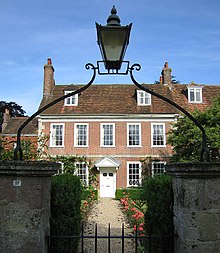Sash window: Difference between revisions
| Line 18: | Line 18: | ||
*[http://www.rmears.co.uk/guides/sash/index.htm Sash Windows: A Guide to Repair of Sash Windows] |
*[http://www.rmears.co.uk/guides/sash/index.htm Sash Windows: A Guide to Repair of Sash Windows] |
||
*[http://www.historic-scotland.gov.uk/ |
*[http://http://www.historic-scotland.gov.uk/sashcase.pdf Historic scotland's sash maintenance guide Historic scotland's sash maintenance guide |
||
[[Category:Windows]] |
[[Category:Windows]] |
||
Revision as of 09:57, 1 May 2008

A sash window or hung sash window is made of one or more movable panels or "sashes" that form a frame to hold panes of glass which are often separated from other panes (or "lights") by narrow muntin bars.[1] Although any window with this style of glazing is technically "a sash", the term is used almost exclusively to refer to windows where the glazed panels are opened by sliding vertically, or horizontally in a style known as a "Yorkshire light" or sliding sash. Sash windows are common in Europe and former colonies including the United States and many developing nations. The design of the sash window is attributed to the English scientist and inventor, Robert Hooke[2]
The sash window is often found in Georgian and Victorian houses, and the classic arrangement has three panes across by two up on each of two sashes, giving a "six over six" panel window, although this is by no means a fixed rule. Innumerable late Victorian and Edwardian suburban houses were built in England using standard sash window units approximately 4 feet (1.2m) in width, but older, hand-made units could be of any size, as the image illustrates.

To facilitate operation, the weight of the glazed panel is usually balanced by a counter-weight concealed within the window frame. This is connected to the window by a sash cord or chain which runs over a pulley at the top of the frame, although spring balances are sometimes used. Sash windows may be fitted with simplex hinges which allow the window to be locked into hinges on one side while the counterbalance on the other site is detached, allowing the window to be opened for escape or cleaning.
The name "hung sash window" is more usual in the United States, and typically refers to a double hung window with two sashes that can move up and down in the window frame. A single hung window has two sashes but normally the top sash is fixed and only the bottom sash slides. Triple and quadruple hung windows are used for tall openings, common in New England churches.
Construction is usually of softwood, and units are generally single glazed; although double-glazed sashes are available it is more common for single-glazed sash windows to be replaced with top-hung casements when double glazing is retro-fitted. Some top-hung double-glazed units are manufactured to give the appearance of sashes. Traditional problems with wooden sash windows include rot, swelling or distortion of the woodwork, rattling in the wind (due to shrinkage of the wood), and problems brought on by careless application of paint. The sliding mechanism makes sash windows more vulnerable to these problems than traditional casement windows. Sash windows are relatively high maintenance, but offer advantages in return (looks, abides by laws (relating to older houses and buildings), natural resources etc). It is also possible to clean all the glass from within the building by sliding the two panes to different positions.
References
External links
- Sash Windows: A Guide to Repair of Sash Windows
- [http://http://www.historic-scotland.gov.uk/sashcase.pdf Historic scotland's sash maintenance guide Historic scotland's sash maintenance guide
